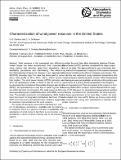Characterization of wind power resource in the United States
Author(s)
Gunturu, Udaya Bhaskar; Schlosser, C. A.
DownloadGunturu-2012-Characterization of.pdf (4.177Mb)
PUBLISHER_CC
Publisher with Creative Commons License
Creative Commons Attribution
Terms of use
Metadata
Show full item recordAbstract
Wind resource in the continental and offshore United States has been reconstructed and characterized using metrics that describe, apart from abundance, its availability, persistence and intermittency. The Modern Era Retrospective-Analysis for Research and Applications (MERRA) boundary layer flux data has been used to construct wind profile at 50 m, 80 m, 100 m, 120 m turbine hub heights. The wind power density (WPD) estimates at 50 m are qualitatively similar to those in the US wind atlas developed by the National Renewable Energy Laboratory (NREL), but quantitatively a class less in some regions, but are within the limits of uncertainty. The wind speeds at 80 m were quantitatively and qualitatively close to the NREL wind map. The possible reasons for overestimation by NREL have been discussed. For long tailed distributions like those of the WPD, the mean is an overestimation and median is suggested for summary representation of the wind resource. The impact of raising the wind turbine hub height on metrics of abundance, persistence, variability and intermittency is analyzed. There is a general increase in availability and abundance of wind resource but there is an increase in intermittency in terms of level crossing rate in low resource regions.
Date issued
2012-10Department
Massachusetts Institute of Technology. Joint Program on the Science & Policy of Global ChangeJournal
Atmospheric Chemistry and Physics
Publisher
Copernicus GmbH
Citation
Gunturu, Udaya Bhaskar, and C. A. Schlosser. “Characterization of Wind Power Resource in the United States.” Atmospheric Chemistry and Physics 12.20 (2012): 9687–9702.
Version: Final published version
ISSN
1680-7324
1680-7316